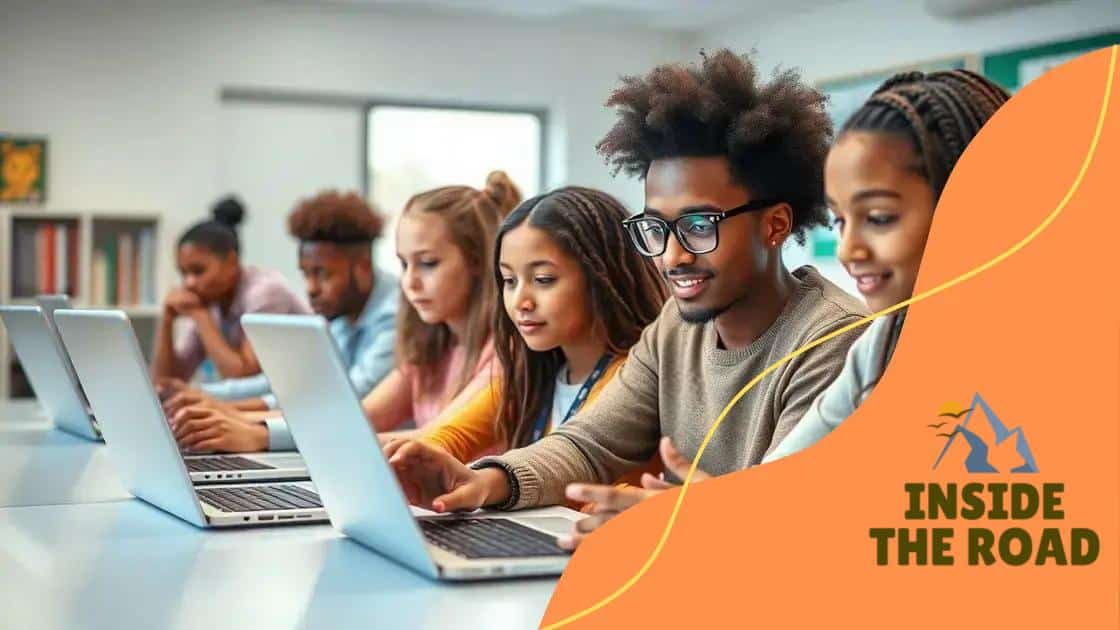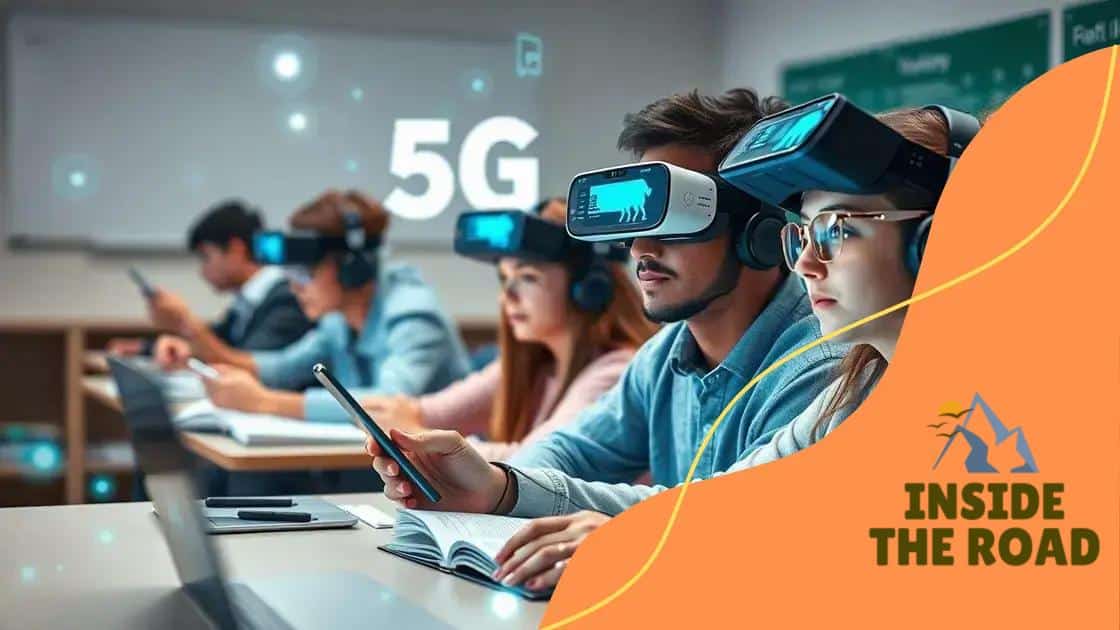Impact of 5G on enhancing online learning experiences

The impact of 5G on enhancing online learning experiences includes faster speeds, improved connectivity, and the ability to access innovative educational tools like VR and AR, resulting in more engaging and personalized education.
The impact of 5G on enhancing online learning experiences is reshaping how students engage with educational content. Imagine accessing high-definition lectures in real-time, no buffering and seamless interactions with peers and instructors. Sounds appealing, right?
What is 5G technology?
5G technology is the fifth generation of mobile network technology, providing faster speeds and more reliable connections than its predecessors. It enhances the way we use mobile devices, enabling seamless access to information and services.
This new technology operates on a higher frequency spectrum, allowing it to transmit data at unprecedented rates. Users can experience download speeds that are exponentially faster, making activities like streaming videos and participating in online classes smoother and more efficient.
Key Features of 5G Technology
- Increased Speed: 5G can deliver speeds of up to 10 Gbps, significantly outperforming 4G.
- Lower Latency: 5G reduces the time it takes for data to travel, providing near-instant communication.
- Higher Capacity: This technology supports a larger number of devices simultaneously without sacrificing performance.
As more devices connect to the internet, such as smart appliances and IoT devices, the demand for faster and more reliable connections grows. 5G technology meets this demand well. It can serve multiple users in crowded areas, ensuring that everyone has access to high-speed internet.
Moreover, 5G enhances mobile learning experiences significantly. Imagine a classroom where students can access highest-quality audiovisual content without interruptions. With 5G, educators can deliver immersive lessons that keep students engaged.
This technology is not just about speed; it also opens doors for innovative learning methods. For example, virtual and augmented reality applications become more feasible. Students can participate in remote simulations or collaborate on projects with peers globally.
How 5G improves online learning environments
5G technology significantly transforms online learning environments by enhancing connectivity and providing more robust tools for engagement. Students and educators alike experience smoother interactions, thanks to the increased speeds and reduced latency.
With 5G, real-time collaboration becomes easier. Learners can participate in discussions, share resources, and work on group projects without frustrating delays. This capability offers a richer, more dynamic learning experience.
Benefits of 5G in Online Learning
- Enhanced Streaming: Live classes and instructional videos load quickly and stream without interruption.
- Support for VR and AR: Students can engage in immersive experiences, such as virtual field trips and simulations, which deepen their understanding of complex topics.
- Improved Accessibility: Learning materials become more accessible to students in remote areas, ensuring that everyone has equal opportunities to succeed.
Moreover, the higher capacity of 5G networks allows more devices to connect seamlessly at the same time. This means that in a classroom setting, every student can use their device to access lessons without experiencing slowdowns. Imagine an online classroom where each student participates actively and equally, regardless of their location.
Furthermore, educators can use advanced tools for tracking student progress and engagement. For instance, analytics applications can provide insights into individual performance, helping teachers tailor their instruction to meet diverse learning needs. When combined with interactive platforms, 5G ensures that education is not just effective but also engaging.
Examples of 5G applications in education

5G technology in education is not just a concept; it is already being applied in practical ways. Schools and universities across the globe are exploring innovative methods to enhance learning experiences and outcomes.
One prominent example of a 5G application is the use of virtual reality (VR) in classrooms. With a robust connection, students can take virtual field trips, visiting historical sites or exploring the depths of the ocean without ever leaving their classrooms. These immersive experiences engage students on a whole new level, making learning more exciting and impactful.
Key Applications of 5G in Education
- Interactive Learning: Teachers can create real-time quizzes and interactive lessons that students can engage with on their devices.
- Remote Learning: Live classes stream with high quality, allowing students to connect from anywhere, making education accessible.
- Collaborative Projects: Students can work together on projects with peers from different locations, sharing ideas and resources instantly.
- Data-Driven Insights: Schools can use big data to analyze student performance and tailor educational strategies accordingly.
Another exciting application is the integration of augmented reality (AR) in educational materials. For instance, students can use AR apps to bring textbooks to life, viewing 3D models of organs in biology or historical artifacts in history classes. This interactive aspect of learning aids in comprehension and retention.
Moreover, with 5G networks, institutions can deploy advanced learning management systems that track student progress in real-time and send immediate feedback. Teachers can adjust their teaching methods based on data analytics, ensuring that all students receive the support they need to succeed.
Challenges of implementing 5G in schools
Implementing 5G technology in schools offers many benefits, but it also brings several challenges. Addressing these hurdles is crucial for successfully integrating this advanced technology into the educational landscape.
One major challenge is the cost involved in upgrading existing infrastructure. Many schools may need to invest heavily in new hardware, software, and connectivity solutions. This can strain budgets, especially in underfunded districts. Schools must carefully plan and prioritize their spending to effectively manage this transition.
Common Challenges of 5G Adoption in Schools
- Infrastructure Needs: Schools may require new routers and network equipment to support 5G.
- Training Staff: Educators and IT staff must be trained to use new tools and resources effectively.
- Equity Issues: Not all students may have access to devices that can leverage 5G capabilities.
- Health Concerns: Some parents and communities express worry about potential health effects of increased electromagnetic exposure.
Another concern is ensuring that all students have equal access to the technology. While 5G promises enhanced connectivity, students without compatible devices may be left out. Schools need to implement programs that provide access to technology for all students, ensuring that no one is disadvantaged in learning opportunities.
Additionally, teachers and staff require adequate training to maximize the benefits of 5G technology. Without proper training, they may struggle to integrate new tools into their teaching. This can hinder the adoption process, as teachers might feel overwhelmed by these changes.
Future trends of 5G in online learning
The future of 5G technology in online learning is promising and exciting. As this technology continues to develop, its impact on education will become even more significant, offering innovative solutions to enhance learning experiences.
One major trend is the rise of personalized learning experiences. With 5G, educational platforms can analyze vast amounts of data in real-time. This means lessons can be tailored to meet individual student needs, allowing for a more customized approach to education.
Emerging Trends in Online Learning with 5G
- Increased Use of AI: Artificial Intelligence will work with 5G to create adaptive learning environments, responding to students’ learning paces.
- Wider Adoption of VR and AR: Virtual and augmented reality applications will become more mainstream, making immersive learning experiences more accessible.
- Collaboration Tools: Enhanced tools for collaboration will thrive, allowing students from all over the world to work together, breaking geographical barriers.
- Data Analytics: Institutions will leverage data analytics to improve teaching methods and track student performance more effectively.
Moreover, 5G is set to improve connectivity in remote and underserved areas. This means that more students will have access to high-quality online education, which has been a challenge in the past. Schools will be able to reach learners who previously faced barriers due to poor internet access.
In the realm of professional development, educators will benefit from cutting-edge training and resources, facilitated by 5G technology. Online workshops and courses can be delivered in high definition, ensuring teachers have the support they need to innovate in their classrooms.
Conclusion: The integration of 5G technology in online learning is set to revolutionize education. With enhanced connectivity, schools can offer more personalized and interactive learning experiences to students everywhere. While there are challenges to overcome, such as costs and training, the benefits far outweigh them. Students will enjoy immersive learning, equality in access to resources, and educators will be better equipped to teach. As we look to the future, embracing 5G will be key to creating a brighter and more inclusive educational landscape.
FAQ – Frequently Asked Questions about the Impact of 5G on Online Learning
How does 5G technology enhance online learning?
5G technology provides faster internet speeds and lower latency, allowing for smoother streaming of lectures and interactive activities.
What are the main challenges to implementing 5G in schools?
The primary challenges include high costs for infrastructure upgrades, the need for staff training, and ensuring equal access for all students.
What benefits can students expect with 5G in education?
Students can enjoy more personalized learning experiences, access to immersive tools like AR and VR, and improved collaboration with peers.
How does 5G improve teaching efficiency for educators?
With 5G, educators can utilize advanced teaching tools, analyze student performance in real-time, and create more engaging lessons.






